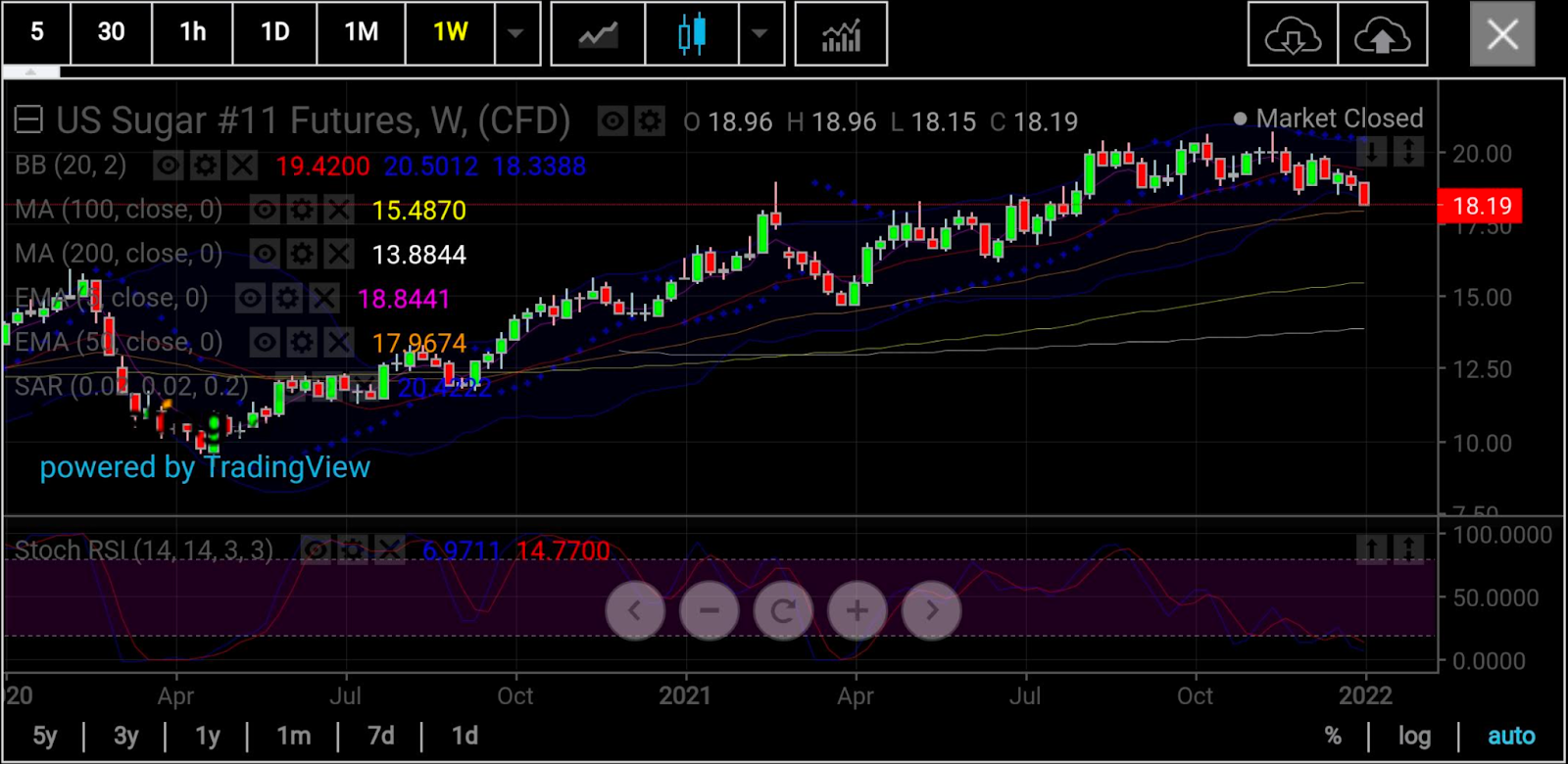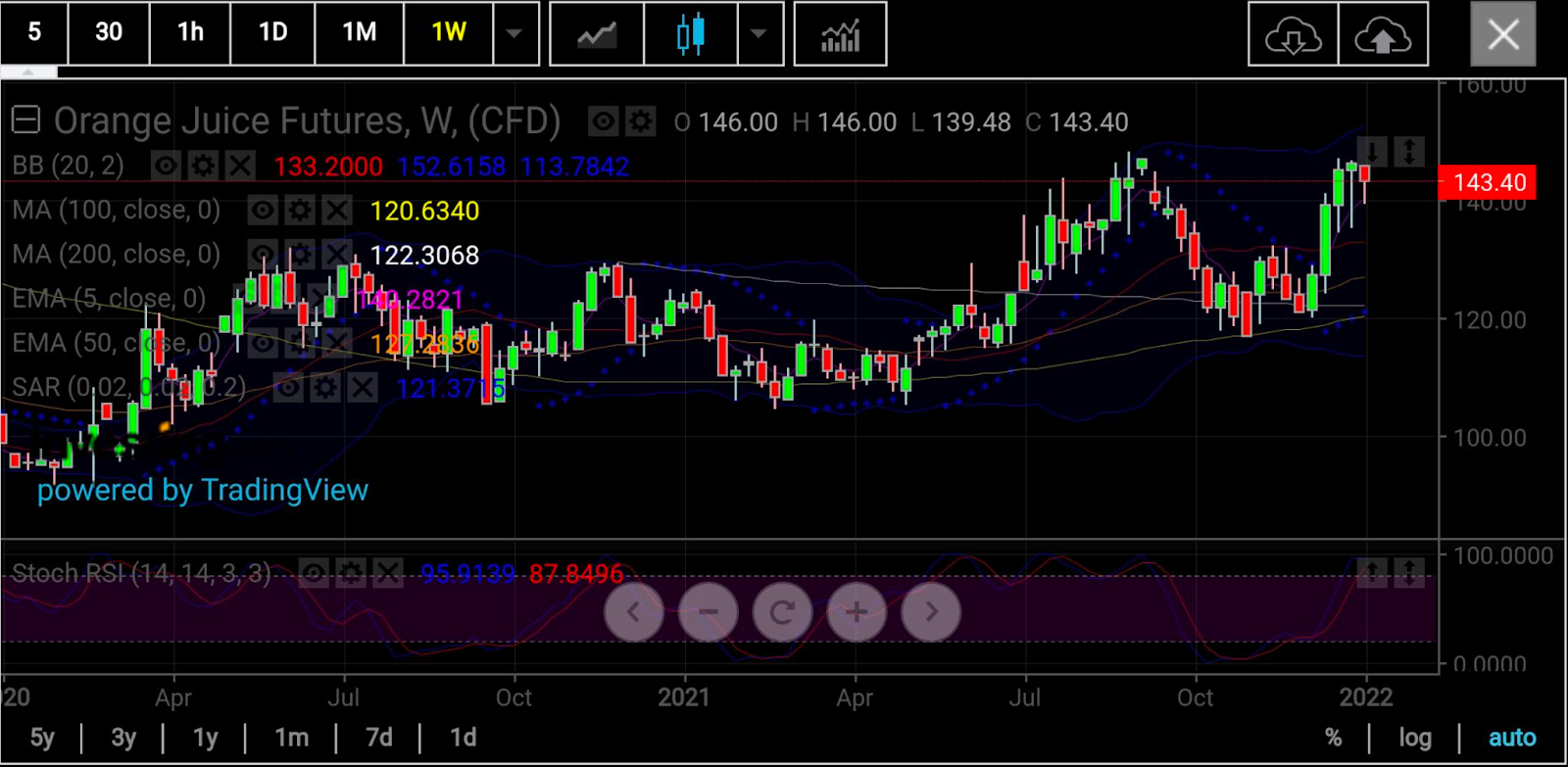In the commodities world, they’re called ‘softs’. But really robusta coffee, sugar, cocoa and orange juice can be labeled ‘fun commodities’ because of the joy people have in consuming them.
Yet, it’s not been a fun start to 2022 for this lot, with the price of each down by 3% to 7% since the year began.
Weather and logistical constraints seemed to be the common issues impacting demand for these commodities, though there are some specifics too.
Let’s explore them individually, to see what’s going on and also learn what the charts say about their price direction in the near term.

All charts courtesy of skcharting.com
Robusta Coffee
On the coffee bean planet, arabica and robusta are both royalty.
Of the two, arabica is widely hailed as king, consumed by 70% of the coffee-drinking world and ranked as the premium bean of choice of renowned coffee chains from Starbucks (NASDAQ:SBUX) to Restaurant Brands (NYSE:QSR) owned Tim Hortons, as well as Dunkin Donuts.
Robusta, while being queen, accounts for almost all of the instant coffee brands in the market. Instant coffee needs 'less fragile' beans due to the longer shelf life demanded of them and they also need to be economical, or simply cheap, for the masses to consume. Robusta fits the bill as it is hardy for storage and also sells for less than arabica because it has a longer harvest season. Robusta is a natural choice as well for decaffeinated coffee due to its bitter, harsh tasting bean that retains flavor after decaffeination. So, if you're drinking decaf, it's most probably robusta.
At the time of writing, arabica’s spot contract on ICE Futures US was up 2.6% on the year, extending a 76% rally from 2021.
But the front-month in robusta, traded on ICE Futures Europe, was down 7.2% since the start of January, diverging from last year’s spectacular gain of 81%.
Vietnam is the largest producer of robusta, with the bean accounting for around 95% of all coffee grown in the Southeast Asian country. Brazil, too, produces a large amount of robusta, which is also grown to a lesser extent in other Asian countries such as Indonesia and India, as well as in some parts of Africa, where it was found.
Jack Scoville, chief crop analyst at Chicago’s Price Futures Group says dry weather and freezing conditions in Brazil have created a lot of problems this year for robusta trees to form the cherries that eventually produce the beans required by coffee grinders.
“Containers are not available in Vietnam or in Brazil to ship the coffee,” said Scoville, adding:
“Cherry pickers are hard to find in Vietnam due to COVID problems. Vietnam is getting scattered showers on the coast but dry conditions inland. The rest of Southeast Asia should get scattered showers in the islands and mostly dry conditions on the mainland. Production conditions for the next crop in Colombia are not really good.”
Sunil Kumar Dixit, chief technical strategist at skcharting.com, said despite opening the year on a low key, robusta could keep its head above water and pull away from its current red patch.
“Holding above the weekly middle Bollinger Band of $2,247 would be important for the continuation of robusta’s upside to challenge its recent $2,499 top,” Dixit said.

Sugar
The spot contract for raw sugar on ICE Futures was up 22% last year, extending a rally that began right after the COVID-19 outbreak of 2020 disrupted output and supply of the sweetener to the global market.
Since 2022 began, however, the spot US sugar futures contract has been down 3.7%.
Some of the recent weakness in sugar can be traced back to the end-2021 period where COVID conditions emerging from the Omicron variant this time caused a demand drop in Europe, which went into new lockdowns on concerns of infections, said Scoville.
“Some stores and restaurants are closing in the US,” added Scoville.
“However, the effects of the new variant are reported to be mild, so the fears are less. Ideas are that the supplies are available from India and Thailand but it will take a stronger price to get them into the market.”
Dixit said sugar’s weekly chart showed prices are coiling below the middle Bollinger Band of 19.42 cents and are slightly above the 50-week Exponential Moving Average of 17.96.
“The oversold stochastic reading of 6.97/14.77 indicates a likely upward reversal to the 19.40 - 20.40 area,” he said.
“However, a break below 17.96 may extend sugar’s weakness to 16.50 and the 100 week Simple Moving Average to 15.50.”

Cocoa
Cocoa finished 2021 down by a modest 3.2%, underperforming other softs.
This year, it has extended that red ink by 3.9%.
The confection and beverage material—which is the chief ingredient for chocolates, ice-cream, baked goods and cocoa powder—is basically a luxury item that thrives in feel-good times and wilts when consumers’ moods aren’t really cheery. COVID infection spikes and ensuing lockdowns have not been good for cocoa, which suffered from both the early 2021 spike of the Delta variant and most recently Omicron’s.
Dixit said cocoa’s broad scenario was not encouraging in the near-term, with the beverage and confection material remaining trapped in the red zone and well below major moving averages.
“Prices are trapped in the $2,630 to $2,320 range,” he said.
“On near term, cocoa is likely to weaken further, to below $2,300.”

Orange Juice
Orange juice is one of America’s foremost breakfast staples, often complimenting coffee as the accompaniment to toast or even substituting it.
OJ as it’s popularly known in trading circles—shorthand for its full trading term Frozen Concentrated Orange Juice (FCOJ)—finished up almost 19% last year.
Since January began, OJ is down 3.4% though.
Scoville cited good crop conditions in most parts of the orange-growing world, particularly 'Sunshine State Florida' and even Mexico that led to ideas of higher production and negated the impact of bad weather in top citrus producer Brazil.
“Brazil production was down last year due to dry conditions at flowering time and then a freeze just before harvest,” said Scoville.
“But weather conditions in Florida are rated mostly good for the crops, with a couple of showers and warm temperatures. Mexican crop conditions in central and southern areas are called good with rains. Northern and western Mexico is rated in good condition."
Dixit noted that OJ has struggled to get above its August high of $1.48, and could remain in troubled waters unless it broke out without making new lows.
“Prices need momentum to break above and target $1.52 next,” he said.
“Correction in near term may push OJ to as low as $1.33”
Disclaimer: Barani Krishnan uses a range of views outside his own to bring diversity to his analysis of any market. For neutrality, he sometimes presents contrarian views and market variables. He does not hold a position in the commodities and securities he writes about.
